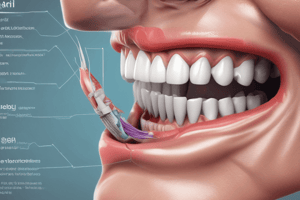Podcast
Questions and Answers
What is the hardest substance in the human body?
What is the hardest substance in the human body?
- Pulp
- Cementum
- Dentin
- Enamel (correct)
Which tooth classification is primarily used for cutting food?
Which tooth classification is primarily used for cutting food?
- Canines
- Molars
- Incisors (correct)
- Premolars
Which dental tissue is composed of blood vessels, nerves, and connective tissue?
Which dental tissue is composed of blood vessels, nerves, and connective tissue?
- Pulp (correct)
- Dentin
- Cementum
- Enamel
What is the main component of a tooth's root?
What is the main component of a tooth's root?
Which tooth type is characterized by being long and pointed, used for tearing food?
Which tooth type is characterized by being long and pointed, used for tearing food?
What is the purpose of premolars in dental anatomy?
What is the purpose of premolars in dental anatomy?
How many cusps do molars typically have, based on dental anatomy?
How many cusps do molars typically have, based on dental anatomy?
Which structure in the periodontium surrounds the teeth and provides a protective seal?
Which structure in the periodontium surrounds the teeth and provides a protective seal?
What does the periodontal ligament do in dental anatomy?
What does the periodontal ligament do in dental anatomy?
Why is a properly aligned dental arch important according to the text?
Why is a properly aligned dental arch important according to the text?
Study Notes
Dental Anatomy: Unveiling the Secrets of the Smile
At the heart of every radiant smile lies a complex and intricate network of structures that form our dental system. Let's delve into the fascinating world of dental anatomy, where each component plays a vital role in maintaining oral health.
The Tooth
The tooth, or dentition, is the primary focus of dental anatomy. Each tooth is composed of three main layers, or dental tissues:
- Enamel — A hard, mineralized, and translucent outer layer that provides protection and strength. Enamel is the hardest substance in the human body.
- Dentin — A calcified, yet more flexible tissue that lies beneath the enamel and extends to the tooth's core.
- Pulp — A soft, living tissue filled with blood vessels, nerves, and connective tissue that nourishes and supplies the tooth with sensation.
The tooth's crown, or visible part, is composed of enamel and dentin, while the tooth's root is primarily made of dentin with a coating of cementum and fibers from the gum.
Tooth Classification and Shapes
Dental anatomy also includes the classification of teeth into four classes: incisors, canines, premolars (bicuspids), and molars. These classes of teeth are further distinguished by their unique shapes:
- Incisors — Tall, narrow, and chisel-shaped teeth primarily used for cutting food.
- Canines — Long, pointed teeth used for tearing and ripping food.
- Premolars — Flattened teeth with one or two cusps, responsible for grinding and crushing food.
- Molars — Flattened teeth with three or more cusps used for grinding and crushing food.
Dental Arches and Alignment
Dental anatomy extends to the arrangement of teeth within the dental arches, upper and lower, and their alignment. The dental arches are composed of 10 teeth each, arranged in a horseshoe-like configuration.
A properly aligned dental arch promotes efficient chewing, speech, and esthetics. Misalignments, such as crowding or gaps, can lead to dental problems like tooth decay and gum disease.
The Periodontium
The periodontium, or gum and its supporting structures, is a vital part of dental anatomy. The periodontium includes:
- Gingiva — The gum tissue that surrounds the teeth, providing a protective seal and anchoring the teeth in their sockets.
- Periodontal ligament — A fibrous, elastic membrane that connects the tooth to the surrounding alveolar bone, allowing the tooth to move slightly in response to forces.
- Alveolar bone — The bone that forms the socket of the tooth and provides a firm foundation for the tooth's root.
Understanding dental anatomy is essential not only for oral health professionals but also for individuals seeking to maintain a healthy, functional, and attractive smile. As we continue to refine our knowledge and understanding of dental anatomy, the future holds exciting possibilities for improving oral health and promoting healthy smiles for all. were not directly related to dental anatomy but were included for context in the search results provided.
Studying That Suits You
Use AI to generate personalized quizzes and flashcards to suit your learning preferences.
Description
Explore the intricate network of dental structures that make up the foundation of our smiles in this quiz about dental anatomy. From the composition of teeth to tooth classification, shapes, dental arches, alignment, and the importance of the periodontium, delve into the fascinating world of oral health.




